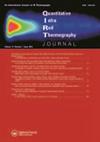微气候指标对植物水分监测精度的影响——以半干旱地区为例
IF 4.9
3区 工程技术
Q1 INSTRUMENTS & INSTRUMENTATION
引用次数: 5
摘要
摘要植物水分胁迫对植物温度的影响越来越大,因此可以通过热像仪远程监测植物水分胁迫。为了更准确地估计工厂用水状况,应根据环境条件对其温度进行归一化。在本文中,目的是研究最近提出的一种归一化方法,该方法使用人造参考表面、一天中不同的测量时间和关于太阳轨迹的不同捕获方向。在一天中的三个不同时间,从橄榄树冠阳光照射的一侧沿两个方位角拍摄到了正面图像。利用Tc和干湿参考面温度计算了两种不同的胁迫指数,即作物水分胁迫指数(CWSI)和气孔导度指数(IG)。不同胁迫水平下的树木通过早晨测量的平均冠层温度(Tc)可以更好地区分。此时,Tc还提供了更高的与气孔导度(SC)的相关指数,而不是基于中午和下午测量的Tc计算的那些指数。比较两个测量方向,第一个方向在上午为Tc提供了较高的相关指数,而第二个方向在下午为Tc。在大多数测量条件下,以空气温度加5度作为干燥参考温度计算的应力指数与SC的相关性更高。本文章由计算机程序翻译,如有差异,请以英文原文为准。
Effect of micro climatic indices on the accuracy of thermographic plant water status monitoring, case study of a semi-arid area
ABSTRACT Plant water stress can be remotely monitored by means of thermography due to its increasing effect on plant temperature. For a more accurate estimation of plant water status, its temperature should be normalised against environmental conditions. In this paper, the aim was to investigate a recently proposed method of normalisation using artificial reference surfaces, different measurement times in a day and different capturing directions regarding to solar trail. At three different times of the day, frontal images were captured from the sunlit side of the olive canopies in two azimuth directions. Two different stress indices of crop water stress index (CWSI) and stomatal conductance index (IG) were calculated using Tc and the temperatures of wet and dry reference surfaces. Trees in different stress levels discriminated better via mean canopy temperature (Tc) of morning measurements. At this time, Tc also provided higher correlated indices with stomatal conductance (SC) rather than those indices calculated based on Tc measured at noon and afternoon. Comparing two measurement directions, the first direction provided Tc with higher correlated indices at morning but the second direction at afternoon. In the most of the measurement conditions, stress indices calculated with air temperature plus five degrees as dry reference temperature had higher correlation with SC.
求助全文
通过发布文献求助,成功后即可免费获取论文全文。
去求助
来源期刊

Quantitative Infrared Thermography Journal
Physics and Astronomy-Instrumentation
CiteScore
6.80
自引率
12.00%
发文量
17
审稿时长
>12 weeks
期刊介绍:
The Quantitative InfraRed Thermography Journal (QIRT) provides a forum for industry and academia to discuss the latest developments of instrumentation, theoretical and experimental practices, data reduction, and image processing related to infrared thermography.
 求助内容:
求助内容: 应助结果提醒方式:
应助结果提醒方式:


